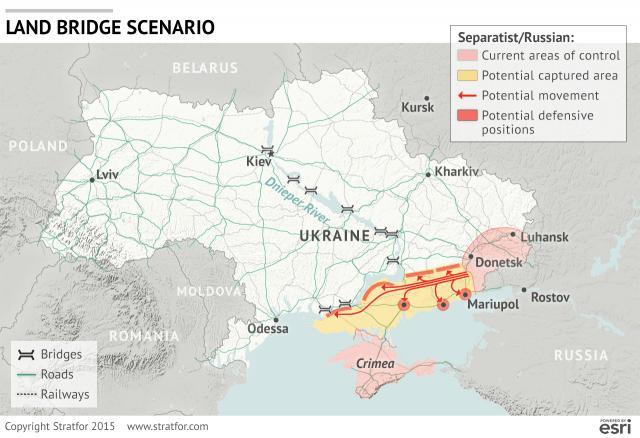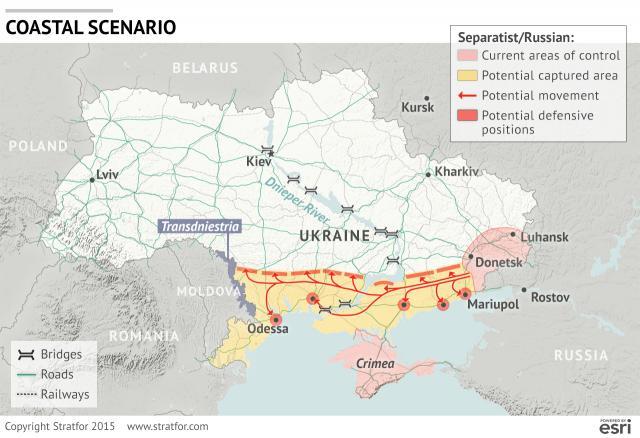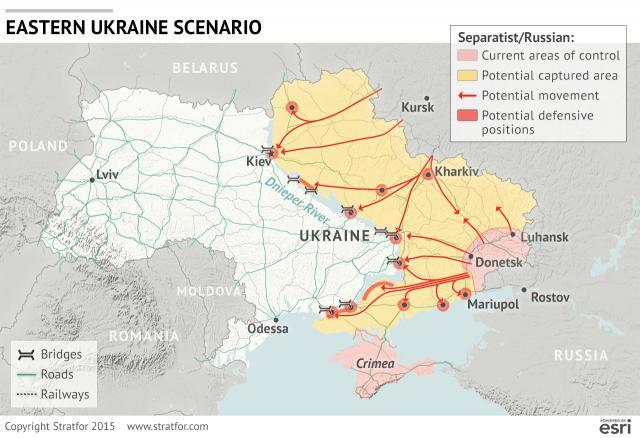Russia's Military Options in Ukraine -: Gaming a Russian Offensive
Politics / Ukraine Civil War Mar 12, 2015 - 02:05 PM GMTBy: STRATFOR
 Editor's Note: As part of our analytical methodology, Stratfor periodically conducts internal military simulations. This series, examining the scenarios under which Russian and Western forces might come into direct conflict in Ukraine, reflects such an exercise. It thus differs from our regular analyses in several ways and is not intended as a forecast. This series reflects the results of meticulous examination of the military capabilities of both Russia and NATO and the constraints on those forces. It is intended as a means to measure the intersection of political intent and political will as constrained by actual military capability. This study is not a definitive exercise; instead it is a review of potential decision-making by military planners. We hope readers will gain from this series a better understanding of military options in the Ukraine crisis and how the realities surrounding use of force could evolve if efforts to implement a cease-fire fail and the crisis escalates.
Editor's Note: As part of our analytical methodology, Stratfor periodically conducts internal military simulations. This series, examining the scenarios under which Russian and Western forces might come into direct conflict in Ukraine, reflects such an exercise. It thus differs from our regular analyses in several ways and is not intended as a forecast. This series reflects the results of meticulous examination of the military capabilities of both Russia and NATO and the constraints on those forces. It is intended as a means to measure the intersection of political intent and political will as constrained by actual military capability. This study is not a definitive exercise; instead it is a review of potential decision-making by military planners. We hope readers will gain from this series a better understanding of military options in the Ukraine crisis and how the realities surrounding use of force could evolve if efforts to implement a cease-fire fail and the crisis escalates.
Russia's current military position in Ukraine is very exposed and has come at a great cost relative to its limited political gains. The strategic bastion of Crimea is defensible as an island but is subject to potential isolation. The position of Ukrainian separatists and their Russian backers in eastern Ukraine is essentially a large bulge that will require heavy military investment to secure, and it has not necessarily helped Moscow achieve its larger imperative of creating defensible borders. This raises the question of whether Russia will take further military action to secure its interests in Ukraine.
To answer this question, Stratfor examined six basic military options that Russia might consider in addressing its security concerns in Ukraine, ranging from small harassment operations to an all-out invasion of eastern Ukraine up to the Dnieper River. We then assessed the likely time and forces required to conduct these operations in order to determine the overall effort and costs required, and the Russian military's ability to execute each operation. In order to get a baseline assessment for operations under current conditions, we initially assumed in looking at these scenarios that the only opponent would be Ukrainian forces already involved in the conflict.
Analysis
One of the most discussed options is a Russian drive along Ukraine's southern coast in order to link up Crimea with separatist positions in eastern Ukraine. For this scenario, we assumed that planners would make the front broad enough to secure Crimea's primary water supply, sourced from the Dnieper, and that the defensive lines would be anchored as much as possible on the river, the only defensible terrain feature in the region. This would in effect create a land bridge to secure supply lines into Crimea and prevent any future isolation of the peninsula. Russia would have to drive more than 400 kilometers (250 miles) into an area encompassing 46,620 square kilometers, establish more than 450 kilometers of new defensive lines, and subdue a population of 2 million.

Taking this territory against the current opposition in Ukraine would require a force of around 24,000-36,000 personnel over six to 14 days. For defensive purposes, Russian planners would have to recognize the risk of NATO coming to Kiev's assistance. Were that to happen, Russia would have to expand the defensive force to 40,000-55,000 troops to hold the territory.
 Planners must also consider the force needed to deal with a potential insurgency from the population, which becomes decidedly less pro-Russia outside of the Donbas territories. Counterinsurgency force structure size is generally based on the size of the population and level of resistance expected. This naturally leads to a much wider variance in estimates. In this scenario, a compliant populace would require a force of only around 4,200 troops, while an extreme insurgency could spike that number to 42,000. In this particular case, no extreme insurgency is expected, as it would be in cities such as Dnepropetrovsk, Kharkiv or Kiev. The defensive force could overlap with the counterinsurgency force to some degree if there were no external threat, but if such a threat existed the forces would have to be separate, potentially doubling the manpower required to secure the territory.
Planners must also consider the force needed to deal with a potential insurgency from the population, which becomes decidedly less pro-Russia outside of the Donbas territories. Counterinsurgency force structure size is generally based on the size of the population and level of resistance expected. This naturally leads to a much wider variance in estimates. In this scenario, a compliant populace would require a force of only around 4,200 troops, while an extreme insurgency could spike that number to 42,000. In this particular case, no extreme insurgency is expected, as it would be in cities such as Dnepropetrovsk, Kharkiv or Kiev. The defensive force could overlap with the counterinsurgency force to some degree if there were no external threat, but if such a threat existed the forces would have to be separate, potentially doubling the manpower required to secure the territory.
A similar scenario that has been considered is the seizing of the entire southern coast of Ukraine in order to connect Russia and its security forces in the Moldovan breakaway region of Transdniestria to Crimea. The logic goes that this would cripple Kiev by cutting off access to the Black Sea and would secure all of Russia's interests in the region in a continual arc. In terms of effort required, Russia essentially would be doubling the land bridge option. It would require an attacking force of 40,000-60,000 troops driving almost 645 kilometers to seize territory encompassing 103,600 square kilometers over 23-28 days. The required defensive force would number 80,000-112,000. This would also add a complicated and dangerous bridging operation over a large river. Moreover, the population in this region is approximately 6 million, necessitating 13,200-120,000 counterinsurgency troops.

These first two scenarios have a serious flaw in that they involve extremely exposed positions. Extended positions over relatively flat terrain — bisected by a river in one scenario — are costly to hold, if they can be defended at all against a concerted attack by a modern military force. Supply lines would also be very long throughout the area and, in the scenario that extends beyond the Dnieper River, rely on bridging operations across a major river.
A third scenario would involve Russia taking all of eastern Ukraine up to the Dnieper and using the river as a defensive front line. When it comes to defending the captured territory, this scenario makes the most sense. The Dnieper is very wide in most places, with few crossings and few sites suitable for tactical bridging operations, meaning defending forces can focus on certain chokepoints. This is the most sensible option for Russia if it wants to take military action and prepare a defensive position anchored on solid terrain.

However, this operation would be a massive military undertaking. The force required to seize this area — approximately 222,740 square kilometers — and defeat the opposition there would need to number 91,000-135,000 troops and advance as much as 402 kilometers. Since the river could bolster defensive capabilities, the defensive force could remain roughly the same size as the attacking force. However, with a population of 13 million in the area, the additional troops that might be required for the counterinsurgency force could range from 28,000-260,000. Russia has approximately 280,000 ground troops, meaning that the initial drive would tie down a substantial part of the Russian military and that an intense insurgency could threaten Russia's ability to occupy the area even if it deployed all of its ground forces within Ukraine.
One positive aspect would be that this operation would take only 11-14 days to execute, even though it involves seizing a large area, because Russia could advance along multiple routes. On the other hand, the operation would require such a vast mobilization effort and retasking of Russian security forces that Moscow's intent would be detectable and would alarm Europe and the United States early on.
Two remaining options that we examined were variations on previous themes in an effort to see if Russia could launch more limited operations, using fewer resources, to address similar security imperatives. For example, we considered Russia taking only the southern half of eastern Ukraine in an effort to use decidedly less combat power, but this left the Russians with an exposed flank and removed the security of the Dnieper. Similarly, a small expansion of current separatist lines to the north to incorporate the remainder of the Donetsk and Luhansk regions to make the territory more self-sustaining was considered. Both operations are quite executable but gain little in the grand scheme.
The final scenario we considered was the most limited. It involved Russia conducting small temporary incursions along the entirety of its border with Ukraine in an effort to threaten various key objectives in the region and thus spread Ukraine's combat power as thin as possible. This would be efficient and effective for the Russian military in terms of the effort required. It could accomplish some small political and security objectives, such as drawing Ukrainian forces away from the current line of contact, generally distracting Kiev, or increasing the sense of emergency there, making the Ukrainians believe Russia would launch a full invasion if Kiev did not comply.
For all of the scenarios considered, the findings were consistent: All are technically possible for the Russian military, but all have serious drawbacks. Not one of these options can meet security or political objectives through limited or reasonable means. This conclusion does not preclude these scenarios for Russian decision makers, but it does illuminate the broader cost-benefit analysis leaders undertake when weighing future actions. No theoretical modeling can accurately predict the outcome of a war, but it can give leaders an idea of what action to take or whether to take action at all.
- Part 1: Gaming a Russian Offensive
- Part 2: What the West Could Do
- Part 3: Russia Weighs the Cost
"Gaming a Russian Offensive is republished with permission of Stratfor."
This analysis was just a fraction of what our Members enjoy, Click Here to start your Free Membership Trial Today! "This report is republished with permission of STRATFOR"
© Copyright 2015 Stratfor. All rights reserved
Disclaimer: The above is a matter of opinion provided for general information purposes only. Information and analysis above are derived from sources and utilising methods believed to be reliable, but we cannot accept responsibility for any losses you may incur as a result of this analysis.
STRATFOR Archive |
© 2005-2022 http://www.MarketOracle.co.uk - The Market Oracle is a FREE Daily Financial Markets Analysis & Forecasting online publication.



